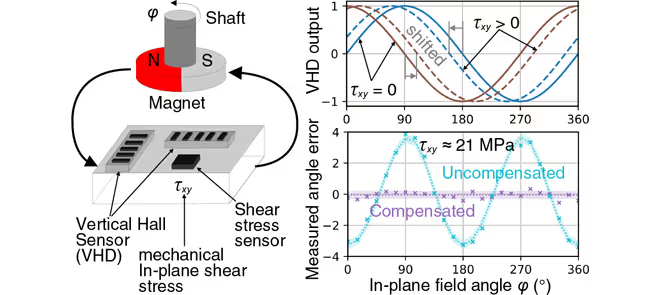Active Compensation of Shear-Stress-Related Nonorthogonality in CMOS Vertical Hall-Based Angle Sensors
Accurate low-cost angle measurements are paramount and ubiquitous in the health and consumer market, industrial automation, robotics, and automotive applications. One common, cheap, and robust method is to measure the orientation of the magnetic flux density of a permanent magnet with two orthogonally arranged Vertical Hall Devices (VHD).
The measurement accuracy with a VHD depends on the misalignment of the sensor array and magnet, imperfections in the fabrication, and in-plane mechanical stresses in the silicon die. This paper presents a novel method to compensate for the systematic orthogonality error induced by those in-plane stresses.
The mechanical stresses are caused either by external forces or the molded package of the sensor. Different thermal expansion coefficients between package, copper lead frame and silicon cause in-plane compressive or tensile stress on the VHD elements. Humidity changes lead to similar effects due to the swelling of the polymer package material. Due to the piezo-Hall effect, these in-plane mechanical stresses influence the electric conductivity of the doped silicon of the VHD which results in an orthogonality error.
Without stress, the two orthogonal VHDs are only sensitive to the magnetic field in either x or y-direction, independent of each other. In the presence of mechanical in-plane stress, a coupling between these orthogonal components, i.e., crosstalk, is caused by the piezo-Hall effect.
For the compensation, a co-integrated stress sensor was placed onto the chip close to the VHD. It introduced an active compensation method to counterbalance the effect of in-plane mechanical stress by a balanced mixing of the two channels. With this method, just one compensation parameter must be defined. The temperature dependence of this parameter is given by the temperature dependence of acting piezo-Hall and piezo-resistive coefficients. The results show that the ratio between orthogonality error and the stress sensor signal is consistent between multiple devices. This means the parameter fit can be done over multiple sensors for fixed production parameters.
This paper presents the relevant theory and derives the active compensation method. A 3D simulation of the VHD, including the piezo-Hall and piezo-resistance effects in silicon, confirmed the expectation for VHD crosstalk and the corresponding compensation method.
To verify the method on a chip, multiple prototypes were fabricated where the stress sensor, the VHD, and the compensation circuit are implemented in CMOS technology. This sensor is mounted on a long ceramic substrate and is then placed in a test setup where the stress is induced by torsion of the ceramic substrate. A defined permanent magnet delivers a known magnetic field strength and orientation. In addition, the temperature can be controlled by resistive heaters. Four test chips were measured at temperatures between 26°C and 96°C.
The orthogonality error showed a systematic maximum of 3.6° and a standard deviation (STD) of 2.5° for a 360° rotation without compensation. It demonstrated that the compensation reduces systematic orthogonality errors down to 0.1° and a noise-limited standard deviation of 0.28°. Without the influence of noise, both values are expected to converge.




